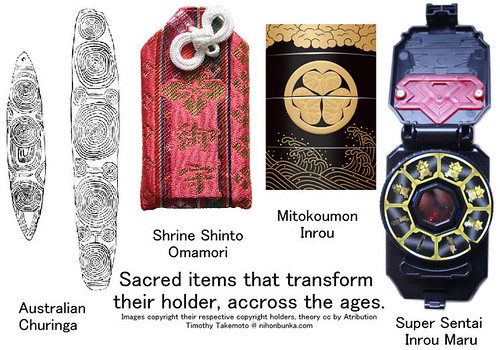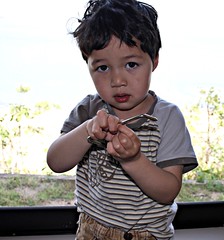Sunday, May 23, 2010
Japanese Nutritional Supplement Energy Drinks
The Japanese drink a lot of nutritional supplement energy drinks, containing royal jelly, ginseng, maka, various vitamins and minerals and their prime effective ingredient: caffine and nicotine. Their effect is I believe, therefore equivalent to the esspresso and cigarette so popular in Italy and France. These drinks are advertised on prime time television, on sale in prime locations even in convenience stores, and can be consumed on the premises of chemists. I think that the Japanese love of energy drinks may be related to the tradition of Eastern medicine and the herbal potions provided by its practioners.
Labels: japanese culture, nihonbunka, 日本文化
Engrish T-Shirts
About half of the T-shirts on sale in Japan have lettering on them. Of those that do, 99% have English or rather Engrish printed upon them. It is almost impossible to find T-shirts with Japanese language written on them. Imagine if it were impossible to purchase English language T-shirts in the UK, and that all lettering on them were in Bad Japanese. There would be riots.
Perhaps this is not just the effect of Westernization, but also something to do with the way in which Japanese have always imported languages from other nations? Perhaps even if there were no Western influence upon Japan, the Japanese would not wish to write in Japanese upon their own T-shirts. Be that as may, I find the Engrish T-shirts a little more troubling than many of the locals.
At the same time, lately, I have taken to wearing a T-shirt upon which is emblazoned "Do! Something on your own way."
Labels: westernisation, 日本文化, 欧米化
Medicines for Atheletes Foot or Dhobi Itch (Jock Itch)
Due to the high degree of humidity, particularly during the rainy season, many Japanese are afflicted with athlete's foot and Dohbi Itch (scrot rot, or jock itch) caused by bacteria infecting moist skin. Fortunately there are a lot of excellent medicines available over the counter that are capable of killing the bacteria with one application. Application can be quite painful, but these medicines often also contain painkillers that dumbs the affected region after the first few seconds. One of the reasons that Japanese use small one-use towels after having a bath is perhaps because bacteria can be stored on any towel that is used more than once.
Labels: athletes foot, culture, dhobi itch, japan, jock itch, たむし, 日本文化, 水虫, 薬
Friday, May 21, 2010
Transformatory sacred items accross the ages

I noted in a previous post that the history of transofmatory items (変身アイテム) such as used by Ultraman (pens and glasses), Super Sentai (Power Rangers), Sailor Moon, Himitsu no Akko-chan, and Kamen Riders (Masked Riders), has a history in the transformatory symbols of Mitokoumon, Touyama no Kin and Samurai Momotarou. Japanese superheroes are always flashing a special symbol and transforming by means of its use.
The history is much older. I ague that Shinto is a geographical totemism, like that of the Arunda/Arunta/Arenda of Australia. In totemic religions the faithful recieve totemic badges which represent their owners and the ancestral spirits of their ancestors. The Arunda of the central Australia destert are one of many such groups found worldwide. Unlike most totemic religions, but in common with the Japanese, these "most primitive" (Freud, Durkheim) of totemists believed that the totem was associated with a place.
That the japanese recieve totemic badges from Shinto shrines almost goes un-noticed. More visible are the symbolic, soul containing badges that are given to the dead (mitama, Ihai). However, as Yanagita Kunio points out, once upon a time, there were "ikimitama" symbols given to the living. These were originally leaves branches of sacred trees and rocks from sacred mountains. They were believed to give their bearer life and were recieved from the time of first shrine visiting.
However in my view, and as Yanagita hints, the symbols were gradually replaced by kanji ideograms and piece of paper.
Yanagita writes, "in this reigion also the Nusa (gohei, zigzag strips of Shinto paper) were originally I think to be distributed among participants. This is similar to the leaves and branches of Japanese cedar and nagi (a evergreen tree/shrub) that were given to the faifthful from sacred trees on Mount Inari and Mount Ise" (Yanagita Kunio Collection No. 14 p 51, my translation.)
「この地方でも小さい幣を関係者に頒(わか)つのが本当の趣旨であったろうと思う。もししかりとすれば、後に言わんとする稲荷山の杉・伊豆山の梛(なぎ)のごとく、信者が神木の木の枝を追って行く風習と、著しく類似する点があるのである」柳田國夫全集14p51
These days Japanese still recieve omamori or amulets from shrines that are said to represent a stand-in or self-replacement and protect the bearer from bad luck and impurity.
And as shrines become less significant, Mitokoumon, Ultramen, Masked Riders, Super Sentai (Power rangers) brandish their sacred symbols and transforms with them.
Before we call the Japanese primitive bricoleurs, let us not forget that "in the beginning was the word," and that I have a "Christian name."Am I transformed by it?
Labels: henshin, Masked Riders, morph, nihobunka, religion, Shinto, specular, Super-Sentai, totemism, ultraman, アニミズム, スパー戦隊, トテミズム, 仮面ライダー, 変身, 宗教, 神道
Stamp Rally and Geographical Totemism
Like the aboriginies the Japanese feel themselves to have descended from a sacred land, created by the spirits in the dream time (mythic time of the Kojiki) and recieve their soul, their breath of life less from their father than from the local shrine spirit. In times past the totemic badge, or symbol which allowed Japanese to transform into living humans, whas a branch from a sacred tree, or a stone from a sacred river bed or mountain. Later, like the Churinga of the Australian aboriginal, and even far far more so, the totemic badges, or names of the Japanese evolved to encompas the use of ideographic language. The "primitive" totemists gradually moved with the times, and imported seals (such as shown in this photograph) from China. No longer did they get a sacred stone or branch from their local shrine, instead they got a piece of paper stamped with the seal of the shrine. These totemic badges live on in the form of Ihai for the dead, the tablets or fuda in household shrines, and the omamori that act as "migawari" or self-replacements, that most Japanese purchase at Shrines every new year.
But why do they need their sacred seals at all? Work in progress.
In the television series "Mirror Man," the hero goes into a mirror and comes back with an amulet. The symbols also seen in all the sumper sentai kamen rider (masked rider) and ultaraman tv programs from the land of the mirror are the meaningful images that allow japanese to identify with their mirror image. They are the images that are always the right way around. The images that have a third person perspective built into them as it were.
Transforming Symbols and Mirrors
Kamen Rider Decade's "Imagin" (Image people jin)
Kamen Rider Decade Mirror world where people are judged!
HImitsu no Akko's compact Mirror
Sailor Moon's compact mirror Chrisis Moon
Super Sentai Shinkenja-'s mirror writing
Super Sentain Shinkenja- inrou maru which shows your face until you insert the symbol, when it shows the super form.
Super Sentai Gaorenja- and the mother-like goddess like person that communicates by mobile phone while looking down through a relfecting surface of a pool of water.
Mirror Man's amulet and reflecting surface
Labels: culture, Jaques Lacan, manga, mirror, nihonbunka, occularcentrism, specular, Super-Sentai, superhero, 日本文化
Japanese Insecticides
I have long been confused by the name "no mat" or "no-matto" refering to a type of insectide product. In the video above there is a wrist attached device that takes small briquettes of insecticide. I therefore presumed that "no-matto" means "No! mat," a mat, or briquette of insecicide, that says "no!" to mosquitoes.
However, I am reliably informed by my wife that on the contrary, Earth (the company) started using the trademark "No-matto" to refer to the vaporisers containing liquid insecticide, rather than their banner product "Eart Matto" (see photo below) which were indeed little mats soaked in an insectide. Later,as shown in the video, even products which contain briquettes of insecticide are sold under the "No Mat" trademark.

All photos and trademarks copyright Earth chemical co Limited.
Labels: culture, japanese culture, 日本文化
Tuesday, May 18, 2010
Nature in Phallocentric and Uterocentric Cultures
Rural Japan is suffering from a lack of inhabitants because the Japanese prefer to live in cities. Upstart gaijin (foreigners) with only a modicum of income are able to purchase beach side houses.
Beaches are not visited.
City-central riverside parks are - apart from certail ritual times of year (such as hanami) - empty.
Riverside cafes and restaurants almost do not exist. There are mountains near and overlooking cities, without paths to their peaks.
The Japanese that love nature, do not go there, or do they?
Japan is a uterocentric (my term for Japan), not phallocentric (Lacan's term for the West), culture. Maybe the late great Hayao Kawaii's terms "boseigenri" (mother architypical) and fuseigenri (father architypical) are better. Not least because, in "phallocentric" cultures, phalli, are hidden. In uterocentric cultures the uterus and its doings are taboo.
"Phallocentric" refers to a idealisation of the male adult who, "castrated," made gentle, a gentleman, Christ-like, is everyone's friend and idol. The Father. Not allowed to be lewd and laviscious, he sublimates himself, kills dragons, champions causes, makes money, creates, becomes rich, fulfills the American dream, and as his (or her) reward, purchases a house in the "stockbroker belt," in nature, on a river, over-looking the sea.
Uterocentric refers to the idealisation of the female adult who is perfected, removed of any hint of womb or menstrual blood, has no desire to give birth, and is every Japanese persons' idol. The Mother. Not alllowed to be base and cowlike (forgive me) she sublimates herself and attends to her (or his) children. As a reward she surfs the ocean of "childhood animism," she sets sail into the uncharted waters of the less-than-seven-year-old infant who, as the Japanese saying goes, is "among the Gods."
Uterocentrists have no need of a haven. They can live in apartments by the station. But in those apartments, and in nearby parks, the Japanese infant Gods frolic, and there is nature in spades.
Labels: japan, japanese culture, Jaques Lacan, lacan, taboo, tabuu, theory, 日本文化
Wednesday, May 12, 2010
Children are Staples (Ko wa Kasugai)
My son here is seen above holding a staple or "kasugai," shown in close up in photo bottom left, which is used to hold two pieces of wood together, see photo bottom right.
In Japanese culture, the love between men and women is seen as being beautiful and natural, but like most things in nature, not particularly permanent. Love, between women and men does not last forever. There is no bridge across forever, no soulmate, no happy end. Japanese love stories tend, or tended, to end in double suicide: the most romantic outcome that one can hope for, at least far more so than domestic bliss.
The love or at least the relationship between parents and children, between ancestors and their descendants is however seen as being eternal. Parents and offspring are considered to be indivisible. No one is born again. This goes for the relationship between children and both mothers and fathers.
So when a couple have a child, while their own emotions for each other may wax and wane, they will be irretrievable linked forever in the flesh of their flesh, their child.
Hence, just as a staple can be used to join two pieces of wood together, so a children are considered to be like staples that join their parents together forever.
Westerners on the other hand are more likely to believe in the possibility of enduring love between men and women, through the transcendence of sexual difference. This hope, that there can be a bridge across forever, is perhaps dependent upon the repression of sex (much less festivals which celebrate sex), which is taboo, repressed, something to be sublimated into a unisex, shareable, idealised "love". I don't think that I need to refer to any particular cultural phenomenon to persuade Anglophones that Western culture is awash dreams of love. Oh, love.
While the Japanese believe that their view is natural, it may be dependent upon the repression of childbirth (seeing it, the desire for it, expressions of child birth, much less festivals which celebrate childbirth), which is taboo, repressed, and sublimated into a unisex, shareable and idealised "parent-child-love". While ancestor worship, or ancestor veneration, is carried out behind closed doors, the clearest expression of the cult of parent child love in Japan, is in the "monstrous" hegemony of cute found in Japan.
Related there are
Children are the shackles of this world and the next (ko ha sankai no kubikase 子は三界の首枷, こはさんかいのくびかせ) which refers to pretty much the same thing.


Labels: family, gender, nihobunka, nihonbunka, sex, Shinto, 宗教, 日本文化
Wednesday, May 05, 2010
Achieving Three Dimensions by Spinning
If you you have a specular self, permanently in the mirror stage, like mirrorman, and according to me, all Japanese, then being three dimensional can present a conceptual problem, since images only have one dimension. Origami paper folding, so popular in Japan, allows one conceptualisation of the two dimensional becoming three - like cubism.
Another is the ability to spin. Spinning is rife among the heros of young Japanese such as the "Inrou Maru" of Shinkenger and the wheel helmets of Goonger (both types of Power Ranger or super sentai).
And as shown in the video above, young Japanese people like to spin. Later Japanese children perform these ("saka-agari") loops on horizontal steel bars, (tetsubou), provided at Japanese schools. I do not have to ask Ray to spin. At three, he seem to want to do it everyday.
The ability to perform a reverse spin (saka-agari) like this on the inverted U, steel bar (testubou) is a rite of passage, and a requirement of Japanese primary school children. Here is a 5 year old Japaense girl performing serial loops on a horizontal steel pole.
AFAIK we WASPs do not require our children to spin, nor do our children show much inclination to do so. I can't remember there being any spin bars at any of my schools in Britain but perhaps I am mistaken.
Until the Japanese child can, by perspective taking (but in a more literal sense that Mead had in mind), and developing the ability to mirror in the mind, she feels perhaps a sense of lonliness or unease at the back of her neck which she can touch but never see. She can overcome this sense of lack through the games mentioned above.
Labels: culture, japan, japanese culture, nihonbunka, occularcentrism, specular, theory, 日本文化
Japanese Buddhist Chanting
In the above video, some lay practioners chant Buddhist scripture. None of the people that are chanting know the meaning of what they are chanting, but they know it is meaningful. I am not sure which scripture they are chanting. Often it is Hanya Shinkyou or Lotus Heart Sutra, which is a pretty philosophical exposition about emptiness. I think that they are chanting to achieve a bit of enlightenment, purification.
I think that the fact that they do now know what they are saying is important and effective. They are destroying language. Repeat anything, even ones own name, even the most meaningful phonemes, and they will become meaningless after a while. By repeating, chanting, these Buddhists are entering, the mumbo-jumbo, language-free-land, and freeing themselves, purifying themselves of the symbol, the group, society, and returning to their un-symbolised, un-analysed Buddha nature.
They feel that they are praying to the Buddha enshrined here. I think that the Buddha here enshrined approves of their self-and-language-anihilation. They are generally older people. People who do not want to die with this-worldly-public things on their mind. They shake noise-makers, to remind themselves that the soul has many voices, not only the one that they are destroying in their heads.
If Japan is so occularcentric then wouldn't it be a good idea for these Japanese Buddhists to work on their self image more? To disassociate themselves from the image? This ia weak link in Takemoto Theorey of Japan. A great deal (but not all) Japanese Buddhist spiritual practice (shugyou) focuses upon eradicating language, via silence (Za-zen), chanting (all forms of Japanese Buddhism), and unsayable sayings (Zen Koans). At the present time my only answer is that perhaps language is the weakest link in the borromean knot that ties the Japanese self together.
Labels: buddhism, culture, japan, japanese culture, logos, nihonbunka, occularcentrism, theory, 日本文化
Japanese Election Posters
Japanese election posters are the other way (see previous post) in which the electorate gain information about the candidates.
In Japan actions speak louder than words. Indeed, I think that being wordy is viewed in a somewhat negative light. For this reason, none of the election posters contain any detail of policy. Many use the same brief phrases promising action, and at least one stating soley, "Action more than words." Instead, the electorate are provided with the names and large photographs of the candidates striking various positive poses. They were also treated to the greetings broadcast from sound trucks.
Those candidates 45 or so candiates, out of about 55, that were elected recieved only about 1500 votes each.
Bearing in mind the small number of votes required for election, those who were elected may have been successful not because their photo, or name was attractive, or because their sound trucks reached an audience persuadable in this way, but rather because of the votes from those with whom they are connected in one way or another. Thus both the posters, and the sound trucks may be a phatic act, going through the motions of canvassing, whereas the real canvassing may have occured in other ways, not herein described.
Labels: culture, japan, japanese culture, nihonbunka, specular, theory, 日本文化
This blog represents the opinions of the author, Timothy Takemoto, and not the opinions of his employer.


